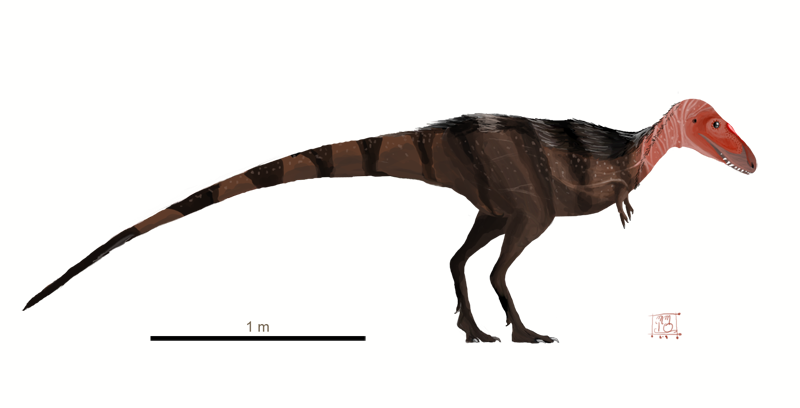Post by Infinity Blade on Jan 26, 2015 2:07:28 GMT 5
Raptorex kreigsteni
Raptorex is a dubious genus of tyrannosaurid dinosaur. Its fossil remains consist of a single juvenile specimen probably uncovered in Mongolia, or possibly northeastern China. The type species is R. kriegsteini, described in 2009 by Sereno and colleagues. The genus name is derived from Latin raptor, "robber", and rex, "king". The specific name honours Roman Kriegstein, a survivor of the Holocaust, whose son Henry Kriegstein donated the specimen to the University of Chicago for scientific study. While initially considered to have come from the Yixian Formation of China, dated to approximately 125 million years ago during the early Cretaceous period, later studies showed that such an early date for the fossil are unlikely, and given its extremely close similarity to juvenile tyrannosaurids of the late Cretaceous, it probably came from the Iren Dabasu or similar formation. Because the specimen is a juvenile, and the changes undergone by tyrannosaurids during growth are not yet well understood, many researchers now consider it to be a nomen dubium, because it cannot be confidently paired with an adult skeleton (though it is extremely similar to juvenile Tarbosaurus bataar skeletons of the same size and age). The only known Raptorex specimen shows the same basic proportions as juvenile tyrannosauroids: a comparatively large and solidly-constructed skull, long legs with adaptations for running, and tiny, two-fingered forelimbs. This is in contrast with more basal tyrannosauroids such as Dilong, which retained features characteristic of more basal other coelurosaurs such as a small head and long, three-fingered forelimbs. The specimen is a very small juvenile, estimated at 3 m (9.8 ft) long and about 65 kg (143 lb). The holotype (LH PV18) measured about 2.5 m (8.2 ft) and died in its third year.

© @ MattMart (Matthew Martyniuk)
Dire Wolf-Canis dirus
The dire wolf (Canis dirus "fearsome dog") is an extinct carnivorousmammal of the genus Canis, roughly the size of the extant gray wolf, but with a heavier build. It evolved in North America and later moved into South America. Canis dirus is assigned to the Rancholabrean land mammal age of North America (240,000-10,000 years BP) and was among the many large carnivores and megaherbivores that became extinct in North and South America near the end of the Pleistoceneepoch. Salamander Cave in the Black Hills of South Dakota has produced the oldest known fossil of what is thought to be a dire wolf. The site preserves a fauna approximately 252,000 years old, based on uranium-series dating of a horse fossil found there. Its ending is associated with the Quaternary extinction event. The dire wolf averaged about 1.5 m (5 ft) in length and weighed between 50 and 79 kg (110 and 174 lb), which made it the largest species in the genus Canis. Limb elements are rarely found outside the La Brea Tar Pits, which makes it hard to compare the size of average individuals between populations. The dire wolf is estimated to have been 8% shorter at the shoulder than the modern Northwestern wolf, and of equal height to the typical gray wolf, but more heavily built. With the exception of the canine teeth in some populations, male and female body and teeth sizes evidence no major sexual dimorphism, similar to most canines. In some populations, males’ canine teeth were considerably larger, suggesting male competition for breeding access. In other populations, lack of dimorphism in the canine teeth suggests little competition. Despite superficial similarities to the gray wolf, the two species differed significantly. Wolves of the Late Pleistocene are genetically unique and morphologically distinct. None of the 16 mtDNA haplotypes recovered from a sample of 20 Pleistocene Eastern-Beringian wolves was shared with any modern wolf. Instead, they appear most closely related to Late Pleistocene wolves found in Eurasia. Today’s largest gray wolves would have been of similar size to an average dire wolf; the largest dire wolves would have been considerably larger than any modern gray wolf. The dire wolf is calculated to have weighed 25% more than living gray wolves. Many of these characteristics were needed to fight off and prey on larger megafauna. The legs of the dire wolf were proportionally shorter and sturdier than those of the gray wolf, and its brain case was smaller than that of a similarly sized gray wolf.

© @ Dantheman9758
Raptorex is a dubious genus of tyrannosaurid dinosaur. Its fossil remains consist of a single juvenile specimen probably uncovered in Mongolia, or possibly northeastern China. The type species is R. kriegsteini, described in 2009 by Sereno and colleagues. The genus name is derived from Latin raptor, "robber", and rex, "king". The specific name honours Roman Kriegstein, a survivor of the Holocaust, whose son Henry Kriegstein donated the specimen to the University of Chicago for scientific study. While initially considered to have come from the Yixian Formation of China, dated to approximately 125 million years ago during the early Cretaceous period, later studies showed that such an early date for the fossil are unlikely, and given its extremely close similarity to juvenile tyrannosaurids of the late Cretaceous, it probably came from the Iren Dabasu or similar formation. Because the specimen is a juvenile, and the changes undergone by tyrannosaurids during growth are not yet well understood, many researchers now consider it to be a nomen dubium, because it cannot be confidently paired with an adult skeleton (though it is extremely similar to juvenile Tarbosaurus bataar skeletons of the same size and age). The only known Raptorex specimen shows the same basic proportions as juvenile tyrannosauroids: a comparatively large and solidly-constructed skull, long legs with adaptations for running, and tiny, two-fingered forelimbs. This is in contrast with more basal tyrannosauroids such as Dilong, which retained features characteristic of more basal other coelurosaurs such as a small head and long, three-fingered forelimbs. The specimen is a very small juvenile, estimated at 3 m (9.8 ft) long and about 65 kg (143 lb). The holotype (LH PV18) measured about 2.5 m (8.2 ft) and died in its third year.

© @ MattMart (Matthew Martyniuk)
Dire Wolf-Canis dirus
The dire wolf (Canis dirus "fearsome dog") is an extinct carnivorousmammal of the genus Canis, roughly the size of the extant gray wolf, but with a heavier build. It evolved in North America and later moved into South America. Canis dirus is assigned to the Rancholabrean land mammal age of North America (240,000-10,000 years BP) and was among the many large carnivores and megaherbivores that became extinct in North and South America near the end of the Pleistoceneepoch. Salamander Cave in the Black Hills of South Dakota has produced the oldest known fossil of what is thought to be a dire wolf. The site preserves a fauna approximately 252,000 years old, based on uranium-series dating of a horse fossil found there. Its ending is associated with the Quaternary extinction event. The dire wolf averaged about 1.5 m (5 ft) in length and weighed between 50 and 79 kg (110 and 174 lb), which made it the largest species in the genus Canis. Limb elements are rarely found outside the La Brea Tar Pits, which makes it hard to compare the size of average individuals between populations. The dire wolf is estimated to have been 8% shorter at the shoulder than the modern Northwestern wolf, and of equal height to the typical gray wolf, but more heavily built. With the exception of the canine teeth in some populations, male and female body and teeth sizes evidence no major sexual dimorphism, similar to most canines. In some populations, males’ canine teeth were considerably larger, suggesting male competition for breeding access. In other populations, lack of dimorphism in the canine teeth suggests little competition. Despite superficial similarities to the gray wolf, the two species differed significantly. Wolves of the Late Pleistocene are genetically unique and morphologically distinct. None of the 16 mtDNA haplotypes recovered from a sample of 20 Pleistocene Eastern-Beringian wolves was shared with any modern wolf. Instead, they appear most closely related to Late Pleistocene wolves found in Eurasia. Today’s largest gray wolves would have been of similar size to an average dire wolf; the largest dire wolves would have been considerably larger than any modern gray wolf. The dire wolf is calculated to have weighed 25% more than living gray wolves. Many of these characteristics were needed to fight off and prey on larger megafauna. The legs of the dire wolf were proportionally shorter and sturdier than those of the gray wolf, and its brain case was smaller than that of a similarly sized gray wolf.

© @ Dantheman9758















